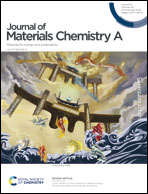A target-customized carbon shell structure of carbon-encapsulated metal nanoparticles for fuel cell applications†
Abstract
The development of Pt-based alloy nanoparticles has contributed to improving fuel cell performance. Nevertheless, the commercialization of the catalysts is limited due to structural stability issues. To enhance the durability of Pt-based alloy catalysts, carbon-encapsulated nanoparticles have been widely studied. However, fine-tuning the carbon shell structure at the atomic scale remains a challenge when adopting a typical top-down approach, which involves a high-temperature graphitization process after polymer coating. Here, we propose a bottom-up approach to carbon encapsulation of Pt3Fe1 nanoparticles. Using extremely small amounts of carbon sources produced by the decomposition of organic ligands in metal precursors, carbon-encapsulated Pt3Fe1 nanoparticles with ultrathin carbon shells are fabricated without additional polymer coating process. Furthermore, the pore structure of the carbon shells is rationally modulated at the sub-nm level without changing the particle size via carbon etching using H2 gas. In-depth studies prove that the fine-tuned carbon shell structure has a significant effect on the activity and durability of Pt3Fe1 nanoparticles. Using the testing protocol suggested by the US Department of Energy, a target-customized carbon shell structure has been discovered that satisfies the 2025 targets of “<30 mV loss at 0.8 A cm−2” and “<40% loss of electrochemical active surface area”.



 Please wait while we load your content...
Please wait while we load your content...